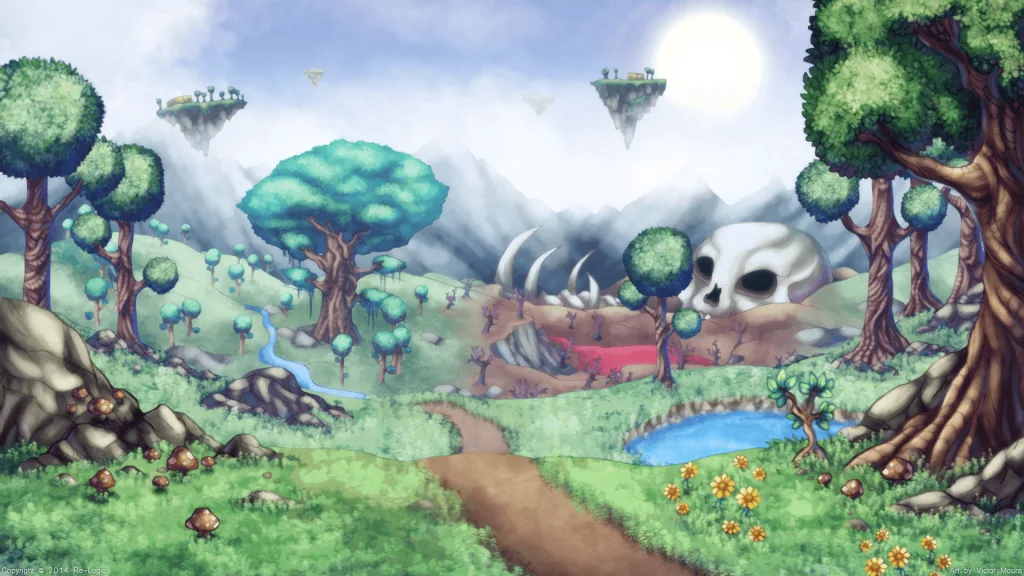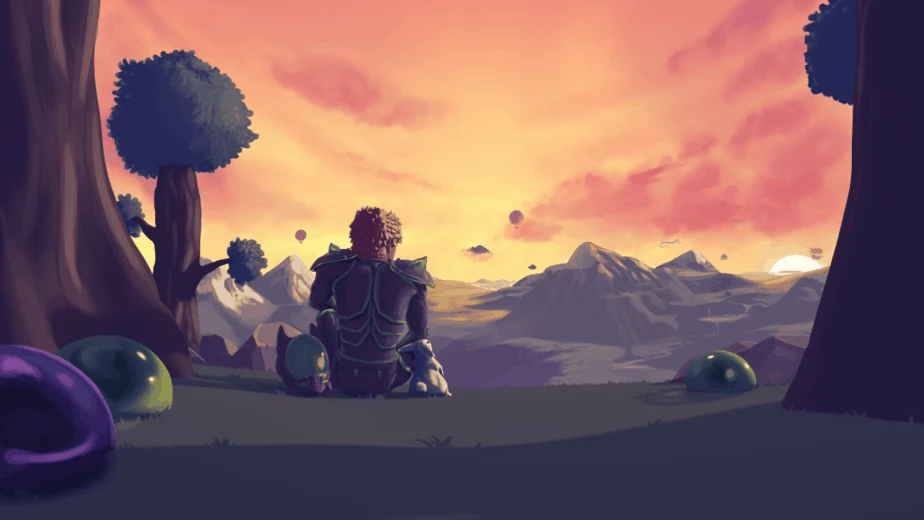How do you stop Corruption in Terraria? Well, stopping it isn’t as important as containing it. That might come as a kick in the teeth to some of you, but it’s simply the truth.
To stop Corruption in Terraria, you must build Hellavators to separate the biomes in your map and connect the Hellevators with two horizontal tunnels that run across the map.
Suppose you’ve blasted ahead and smashed through the Wall of Flesh without any corruption preparation. In that case, you’re probably panicking about all the overgrown ugliness infecting your world.
All is almost lost, but not quite. If you’re keen on keeping your world, you have A LOT of work to do to recover it.
However, you’re better off calling it quits and starting a new world armed with the knowledge of stopping corruption in Terraria before it’s too late.
About Corruption

Before diving into how to prevent Corruption, we need to chat briefly. You see, Corruption, or the corruption mechanic, can be split into three separate biomes instead of just one.
While functionally the same, we must review a few distinct differences between each biome. Otherwise, you’ll be going into your corruption containment half-blind, and we don’t want that.
Hallow
First up is Hallow. Unlike the Corruption and Crimson, of which you can only have one, the Hallow is a guaranteed post-hard mode spawn in every world regardless of seed.
Also, unlike the other two biomes, the Hallow is made up of fantastical, bright-color, fairytale-like themes as opposed to darkness, gore, and decay. It also can’t spread through mud areas found in the likes of Jungles and Glowing Mushroom biomes.
Don’t let its whimsical nature fool you, though. The Hallow is full of dangerous enemies and will spread like wildfire if you don’t deal with it.
Once the Hallow and Underground Hallow biomes spawn, they will begin to spread. Pearlstone, Pearlsand, and dirt blocks with Hallowed grass growing on them will apply to neighbor blocks. It is also capable of spreading over any existing Corruption or Crimson blocks.
Corruption
Corruption is a dark counterpart to Crimson. You can only have one of the two spawn naturally in your world, both pre and post-hard mode, although you can artificially build them into your world.
Corruption is identified by its dark, dreary, purple themes of death and decay.
The Corruption extends underground through chasms, each ending in a Shadow Orb.
Like Crimson and Hallowed, Corruption spreads to susceptible blocks near the pre-existing biome. It can also apply to Deserts, turning them into Corrupted Deserts. The only difference between regular Corruption and the Desert variants is the inclusion of several additional enemies in the latter.
Crimson
Unlike Corruption, Crimson is identified by its stark red color palette. It spreads in an identical method to the other two biomes.
The primary functional difference between the Crimson and Corruption is that Crimson-exclusive enemies tend to have higher stats. To balance that, Crimson materials are slightly more robust than those in Corruption areas.
Crimson Chasms and the Crimson Hearts found at the end only spawn with Crimson biomes and do not form from spreading to new areas. The same method of application is shared by Corruption.
Step 1. Vertical Segmentation
Our method of containing Corruption involves breaking the map into a grid via vertical and horizontal segmentation. You will be mining out this grid, hence the intense focus on increasing your mining speed.
We’re doing this because corruption, Crimson, and Hallow cannot spread more than three blocks. So, by creating a three-block-wide gap between biomes and areas of interest, you’re limiting the movement of these biomes to those segments or sectors.
This has several different advantages aside from stopping Corruption. It is a valuable way to set up farms in the three spreadable biomes and allows for systematic cleansing if you want a 100% purified world.
You will want to build a containment area for your base. This will act as a failsafe in case things go wrong.
You want to dig down on both sides of your base until you’re comfortably deep enough. These vertical tunnels need to be at least three blocks wide. However, Four or Six blocks wide gives you some breathing room if you miss a block or two.
Once you have your two tunnels dug down, you want to connect them with a tunnel that is, again, at least three blocks high.
Once your base is segmented, you can move on to the other areas of your map.
Segmenting Your Biomes
You can segment as much of the map as you want. However, we suggest splitting the world up into quarters. The main idea here is to separate each critical area and biome from the rest of the world, so play with that measurement as you see fit.
Once you know how you want to space out your world, dig your vertical tunnel down along each dividing line, separating all of your biomes.
Unlike your base, you want to dig down until you hit the lava. Make sure you keep up with a consistent four or six-wide tunnel, whichever you decide.
At this point, you should have four vertical lines diving your world up, with each biome getting its sector. If needed, go in and add additional lines where you feel they are required. Once you beat the Wall of Flesh, you’ll get other random Corruption biomes spawning, so you want to make sure it spawns into an area you already have contained.
Pay special attention to your pre-existing Crimson or Corrupted biome – locking them out individually from the rest of the map.
Giving Yourself Breathing Room
Dividing your map up like this is almost enough in and of itself. However, there are some additional steps you can take to secure yourself some more breathing room.
Take any non-corruptable blocks you have, Wood, Snow, etc., and line the ground around your tunnel entrances within six blocks of either size. As well as that, line the tops and bottoms of the horizontal tunnels you’ll dig in the next section with the same blocks.
Step 2. Horizontal Segmentation
With that done, it’s time for you to dig out your horizontal tunnels connecting the vertical ones. These tunnels are going to run across your entire world.
You should only need two of these long tunnels, effectively chopping your world into thirds horizontally.
This result should be grid-like, with your entire world, underground and above ground, separated into segments or sectors.
This completes your containment and should prevent any large-scale spread of Corruption.
Even after the new biomes spawn, once you enter hard mode, your map should be segmented enough that the new areas are separated and isolated into individual chunks.
From here, you must enter hard mode and deal with the consequences. If any adjustments to your grid are needed, prioritize them.
The enemies in these biomes will likely be too strong to handle, so exercise caution if you must venture into them to deal with the Corruption.
Post-Hardmode

Once your map is divided up and you kill the Wall of Flesh, you will enter hard mode.
If you’ve followed our advice, all the hard work should already be done. However, you can do a few other things in hard mode after the fact.
Jungles, in particular, should get much of your post-hard mode attention. Jungle biomes need to be rebuilt brick by brick, making recovering them from Corruption incredibly tedious.
Planting Hallowed Seeds or Pearlstone at the border of Jungles will dramatically slow the spread of evil, buying you time to deal with the infection properly.
Hallow does not infect Jungles, so creating an artificial Hallow around your Jungle will combat both Crimson and Corruption.
Once your Jungles have been preserved, you should identify the newly infected areas.
Hardmode will spawn Hallow and one of the two evils in a V shape randomly in your world. If you have segmented your map well enough, the affected areas should be easy to spot.
Take the time to deal with any necessary emergency actions resulting from the new spawns, being careful to avoid the new enemies.
Once you feel comfortable, you can continue generally playing, with your next milestone being the defeat of a Mechanical Boss. Defeating a Mechanical Boss will spawn The Steampunker. The Steampunker gives you access to the Clentaminator – a tool to purify infected evil areas.
Total Cleansing
With the Clentaminator in hand, you can start combating Corruption at its roots. This is an expensive undertaking, so make sure you have established effective money-making farms before attempting it.
Your primary method of cleaning your world will be using Green Solutions. These solutions will quickly cleanse large potions of the world but don’t prevent the cleaned areas from getting re-infected.
This shouldn’t be too much of a problem for us, though, as we have already quarantined individual areas of the world.
However, using this solution will turn your Glowing Mushroom biomes into Jungle. This can be reversed, though, by using the Dark Blue Solution on your previous pockets of mushrooms.
Cleansing your world like this is the only way to deal with Corruption after hard mode, mainly if you haven’t segmented your world.
If you are in this boat, segment and cleanse your world as you go, doing pockets until you have the nasty infection under control.

